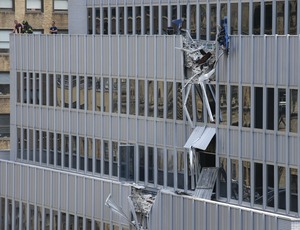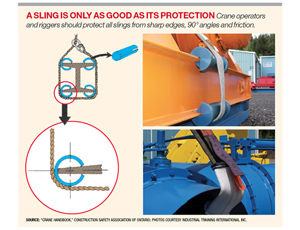A cut sling was the cause of the dropped load accident in Midtown Manhattan last month, believes a confidential source familiar with the investigation.
The accident highlights a vulnerability in rigging procedures. Federal Occupational Safety and Health Administration regulations identify the point of vulnerability, but the agency does not provide detailed guidelines.
The accident occurred when a roughly 13-ton air conditioner was being lifted into place at the top of 261 Madison Ave. in Midtown Manhattan. The load fell 30 stories to the street below early on Sunday morning, May 31.
Madison Avenue is usually a busy thoroughfare, but it is not heavily used on weekends. Because of New York Dept. of Buildings permit conditions for the lift, only one lane was open on the avenue and traffic was light. Ten people, including two construction workers, sustained minor injuries when the load fell.
The load fell because the synthetic sling used to lift it in place was cut, most likely because a sharp edge on the bottom of the load sliced the softener used to protect the sling, the source said. The softener has yet to be found.
The New York Dept. of Buildings had no comment on the cause of the accident and, through a spokesman, said only that the incident is still under investigation.
The air-conditioning unit was being lifted by a mobile crane with a 168-ft telescopic boom with a 207-ft lattice luffing jib. The crane was rented from Bay Crane and operated by Skylift Contractor Corp., both of Brooklyn. Neither firm returned calls for comment by press time.
A study of crane accidents by Haag Engineering Co. found that lost, or dropped, load and rigging failure were the third and fourth most common types of accidents when a load was on the hook.
Softeners, or sling protectors, are commonly used to protect slings at the points where they come into contact with the load. Heavy loads generate extreme pressure at the point of contact, in essence making a dull edge sharper. In addition, if the load shifts, that pressure can generate heat that can melt or burn slings made of synthetic material.
When a sling makes a 90° bend around the corner of a load, there is 40% more pressure created at the corner, according to Mike Parnell, a rigging expert and CEO of Woodland, Wash.-based Industrial Training International Inc. (ITI).
In a study of accidents it has reviewed, ITI found that 50% of the 60 accidents examined were sling-related. The other 50% were either crane-related or the result of a faulty procedure.





Post a comment to this article
Report Abusive Comment